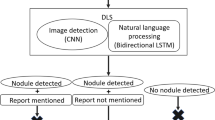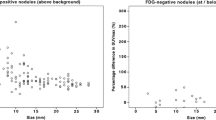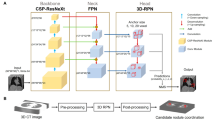Abstract
Objectives
To evaluate the diagnostic performance of a deep learning algorithm for automated detection of small 18F-FDG-avid pulmonary nodules in PET scans, and to assess whether novel block sequential regularized expectation maximization (BSREM) reconstruction affects detection accuracy as compared to ordered subset expectation maximization (OSEM) reconstruction.
Methods
Fifty-seven patients with 92 18F-FDG-avid pulmonary nodules (all ≤ 2 cm) undergoing PET/CT for oncological (re-)staging were retrospectively included and a total of 8824 PET images of the lungs were extracted using OSEM and BSREM reconstruction. Per-slice and per-nodule sensitivity of a deep learning algorithm was assessed, with an expert readout by a radiologist/nuclear medicine physician serving as standard of reference. Receiver-operator characteristic (ROC) curve of OSEM and BSREM were assessed and the areas under the ROC curve (AUC) were compared. A maximum standardized uptake value (SUVmax)–based sensitivity analysis and a size-based sensitivity analysis with subgroups defined by nodule size was performed.
Results
The AUC of the deep learning algorithm for nodule detection using OSEM reconstruction was 0.796 (CI 95%; 0.772–0.869), and 0.848 (CI 95%; 0.828–0.869) using BSREM reconstruction. The AUC was significantly higher for BSREM compared to OSEM (p = 0.001). On a per-slice analysis, sensitivity and specificity were 66.7% and 79.0% for OSEM, and 69.2% and 84.5% for BSREM. On a per-nodule analysis, the overall sensitivity of OSEM was 81.5% compared to 87.0% for BSREM.
Conclusions
Our results suggest that machine learning algorithms may aid detection of small 18F-FDG-avid pulmonary nodules in clinical PET/CT. AI performed significantly better on images with BSREM than OSEM.
Key Points
• The diagnostic value of deep learning for detecting small lung nodules (≤ 2 cm) in PET images using BSREM and OSEM reconstruction was assessed.
• BSREM yields higher SUV max of small pulmonary nodules as compared to OSEM reconstruction.
• The use of BSREM translates into a higher detectability of small pulmonary nodules in PET images as assessed with artificial intelligence.




Similar content being viewed by others
Abbreviations
- 18F-FDG:
-
18F-Fluorodeoxyglucose
- AI:
-
Artificial intelligence
- AUC:
-
Area under the ROC curve
- BMI:
-
Body mass index
- BSREM:
-
Block sequential regularized expectation maximization
- CI:
-
Confidence intervals
- CT:
-
Computed tomography
- FP:
-
False positive
- ILSVRC:
-
IMAGENET Large Scale Visual Recognition Challenge
- OSEM:
-
Ordered subset expectation maximization
- PanCan:
-
Pan-Canadian Early Detection of Lung Cancer Screening Study
- PET:
-
Positron emission tomography
- ROC:
-
Receiver-operator characteristic
- SUVmax :
-
Maximum standardized uptake value
- VOI:
-
Volume of interest
References
Kelloff GJ, Hoffman JM, Johnson B et al (2005) Progress and promise of FDG-PET imaging for cancer patient management and oncologic drug development. Clin Cancer Res 11:2785–2808
Fischbach F, Knollmann F, Griesshaber V, Freund T, Akkol E, Felix R (2003) Detection of pulmonary nodules by multislice computed tomography: improved detection rate with reduced slice thickness. Eur Radiol 13:2378–2383
Wahidi MM, Govert JA, Goudar RK, Gould MK, McCrory DC, American College of Chest Physicians (2007) Evidence for the treatment of patients with pulmonary nodules: when is it lung cancer?: ACCP evidence-based clinical practice guidelines (2nd edition). Chest 132:94S–107S
Quint LE, Park CH, Iannettoni MD (2000) Solitary pulmonary nodules in patients with extrapulmonary neoplasms. Radiology 217:257–261
Taralli S, Scolozzi V, Triumbari EK et al (2019) Is 18F-fluorodeoxyglucose positron emission tomography/computed tomography useful to discriminate metachronous lung cancer from metastasis in patients with oncological history? Q J Nucl Med Mol Imaging. https://doi.org/10.23736/S1824-4785.19.03140-6
Chang ST, Nguyen DC, Raptis C et al (2015) Natural history of preoperative subcentimeter pulmonary nodules in patients with resectable pancreatic adenocarcinoma: a retrospective cohort study. Ann Surg 261:970–975
Baratto L, Park SY, Hatami N et al (2017) 18F-FDG silicon photomultiplier PET/CT: a pilot study comparing semi-quantitative measurements with standard PET/CT. PLoS One 12:e0178936
Ahn S, Fessler JA (2003) Globally convergent image reconstruction for emission tomography using relaxed ordered subsets algorithms. IEEE Trans Med Imaging 22:613–626
Teoh EJ, McGowan DR, Bradley KM, Belcher E, Black E, Gleeson FV (2016) Novel penalised likelihood reconstruction of PET in the assessment of histologically verified small pulmonary nodules. Eur Radiol 26:576–584
Esteva A, Kuprel B, Novoa RA et al (2017) Dermatologist-level classification of skin cancer with deep neural networks. Nature 542:115–118
Lu D, Popuri K, Ding GW, Balachandar R, Beg MF, Alzheimer’s Disease Neuroimaging Initiative (2018) Multimodal and multiscale deep neural networks for the early diagnosis of Alzheimer’s disease using structural MR and FDG-PET images. Sci Rep 8:5697
Schwyzer M, Ferraro DA, Muehlematter UJ et al (2018) Automated detection of lung cancer at ultralow dose PET/CT by deep neural networks - initial results. Lung Cancer 126:170–173
Messerli M, Stolzmann P, Egger-Sigg M et al (2018) Impact of a Bayesian penalized likelihood reconstruction algorithm on image quality in novel digital PET/CT: clinical implications for the assessment of lung tumors. EJNMMI Phys 5:27
fast.ai. Available via https://github.com/fastai/fastai. Accessed May 2019
torchvision.models - PyTorch master documentation. Available via https://github.com/pytorch/vision/tree/master/torchvision/models. Accessed May 2019
Russakovsky O, Deng J, Su H et al (2015) ImageNet large scale visual recognition challenge. Int J Comput Vis 115:211–252
Deng J, Dong W, Socher R, Li LJ, Li K, Li FF (2009) ImageNet: a large-scale hierarchical image database. In: 2009 Ieee Conference on Computer Vision and Pattern Recognition, pp 248–255
Pydicom. Available via https://github.com/pydicom/pydicom Accessed May 2019
Meyer A, Zverinski D, Pfahringer B et al (2018) Machine learning for real-time prediction of complications in critical care: a retrospective study. Lancet Respir Med 6:905–914
Robin X, Turck N, Hainard A et al (2011) pROC: an open-source package for R and S+ to analyze and compare ROC curves. BMC Bioinformatics 12:77
DeLong ER, DeLong DM, Clarke-Pearson DL (1988) Comparing the areas under two or more correlated receiver operating characteristic curves: a nonparametric approach. Biometrics 44:837–845
Lecun Y, Bottou L, Bengio Y, Haffner P (1998) Gradient-based learning applied to document recognition. Proc IEEE 86:2278–2324
He KM, Zhang XY, Ren SQ, Sun J (2016) Deep residual learning for image recognition. 2016 IEEE Conference on Computer Vision and Pattern Recognition (CVPR), pp 770–778
McWilliams A, Tammemagi MC, Mayo JR et al (2013) Probability of cancer in pulmonary nodules detected on first screening CT. N Engl J Med 369:910–919
MacMahon H, Naidich DP, Goo JM et al (2017) Guidelines for management of incidental pulmonary nodules detected on CT images: from the Fleischner Society 2017. Radiology 284:228–243
Occhipinti M, Heidinger BH, Pfannenberg C, Munden RF, Eisenberg RL, Bankier AA (2017) Managing incidental lung nodules in patients with a history of oncologic disease: a survey of thoracic radiologists. J Thorac Imaging 32:115–120
Nomori H, Watanabe K, Ohtsuka T, Naruke T, Suemasu K, Uno K (2004) Evaluation of F-18 fluorodeoxyglucose (FDG) PET scanning for pulmonary nodules less than 3 cm in diameter, with special reference to the CT images. Lung Cancer 45:19–27
THE MNIST DATABASE of handwritten digits. Available via http://yann.lecun.com/exdb/mnist. Accessed May 2019
He KM, Gkioxari G, Dollar P, Girshick R (2017) Mask R-CNN. 2017 IEEE International Conference on Computer Vision (ICCV). arXiv:1703.06870
Yosinski J, Clune J, Nguyen A, Fuchs T, Hod L (2015) Understanding neural networks through deep visualization. arXiv preprint; Available via: https://arxivorg/abs/150606579. Accessed August 2019
Acknowledgments
Dr. Michael Messerli and Dr. Irene Burger received a research grant from the Iten-Kohaut Foundation, Switzerland. Martin W. Huellner received grants from GE Healthcare and a fund by the Alfred and Annemarie von Sick Grant for translational and clinical cardiac and oncological research. The authors would like to thank Josephine Trinckauf, Corina Weyermann, Michèle Hug, and Juliana Koller for their excellent technical support. Further, we thank Fotis Kotasidis (PhD) for his invaluable comments and suggestions regarding this work.
Author information
Authors and Affiliations
Corresponding author
Ethics declarations
Guarantor
The scientific guarantor of this publication is Dr. Michael Messerli.
Conflict of interest
The authors of this manuscript declare relationships with the following companies: Gustav K. von Schulthess is a Consultant to GE Healthcare and a Co-Director of IDKD, an educational organization that receives funds from multiple companies. Martin W. Huellner, Irene A. Burger, and Michael Messerli received speaker’s fees from GE Healthcare. Apart from that, the other authors of this manuscript declare no personal relationships with any companies, whose products or services may be related with the subject matter of the article. The University Hospital Zurich holds a research agreement with GE Healthcare. No further specific grants from funding agencies in the commercial sectors were received for this study.
Statistics and biometry
No complex statistical methods were necessary for this paper.
Informed consent
Written informed consent was obtained from all patients in this study.
Ethical approval
Institutional Review Board approval was obtained.
Methodology
• retrospective
• diagnostic or prognostic study
• performed at one institution
Additional information
Publisher’s note
Springer Nature remains neutral with regard to jurisdictional claims in published maps and institutional affiliations.
Dr. Michael Messerli and Dr. Martin W. Huellner share last authorship
Rights and permissions
About this article
Cite this article
Schwyzer, M., Martini, K., Benz, D.C. et al. Artificial intelligence for detecting small FDG-positive lung nodules in digital PET/CT: impact of image reconstructions on diagnostic performance. Eur Radiol 30, 2031–2040 (2020). https://doi.org/10.1007/s00330-019-06498-w
Received:
Revised:
Accepted:
Published:
Issue Date:
DOI: https://doi.org/10.1007/s00330-019-06498-w




